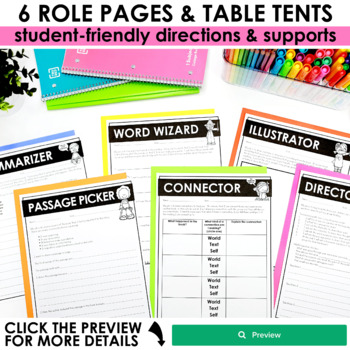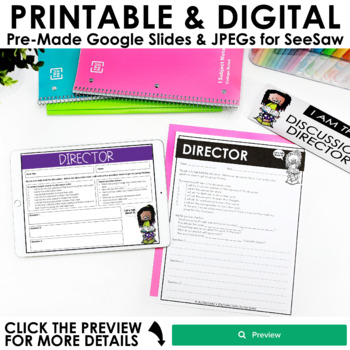Literature Circles - Book Clubs | Roles & Reflection Pages | Print and Digital
- Zip
- Google Apps™

What educators are saying
Description
Literature Circles Adapted for Lower Elementary Grades: Literature Circles make the perfect Book Clubs and are an effective and engaging way to get students invested in reading and they align perfectly with the standards for speaking and listening!
I like to think of Literature Circles as a structured book group. After explicit modeling, these groups can become independent. Each student takes on a role that rotates with each meeting. These roles include discussion director, illustrator, word wizard, connector, summarizer and passage picker.
NEW DIGITAL UPDATE: This resource now includes a digital version with pre-made slides in Google Drive™ as well as image slides to use for different digital platforms. (I do not recommend the digital version for first graders.)
Be sure to check out this blog post to learn how to introduce this resource to your students: https://jillianstarrteaching.com/literature-circles
THIS PRODUCT INCLUDES:
Digital Version Pre-made in Google Slides:
This includes all 6 Literature Circle Role Pages and the Student Reflection/Rubric
6 Role Pages (1 for each of the 6 roles)
These support the structure and routines of Literature Circles, as well as to provide evidence of the discussion for teachers.
6 Table Tents:
One side of the tent faces out to the group signifying their role. The backside is a “cheat sheet” of their role and responsibilities.
Student Reflection/Rubric
This "Group Check-In" page acts as a rubric, and allows students to reflect on how the group performed.
Rules for Literature Circles:
This provides a common understanding of expectations for students. These agreed-upon rules are introduced prior to starting Literature Circles, and revisited with each meeting.
Introduction:
An introduction to Literature Circles and a list of the Common Core State Standards this product aligns with (Grades 1-4).
All Role Pages & Reflection Slides
I have included PNG files of all role pages and the reflection/rubric so you can use these in Seesaw, OneDrive, and other platforms as well!
Other Products That May Interest You
© Jillian Starr • Teaching with Jillian Starr
This product is intended for personal use in one classroom only. For use in multiple classrooms, please purchase additional licenses.





